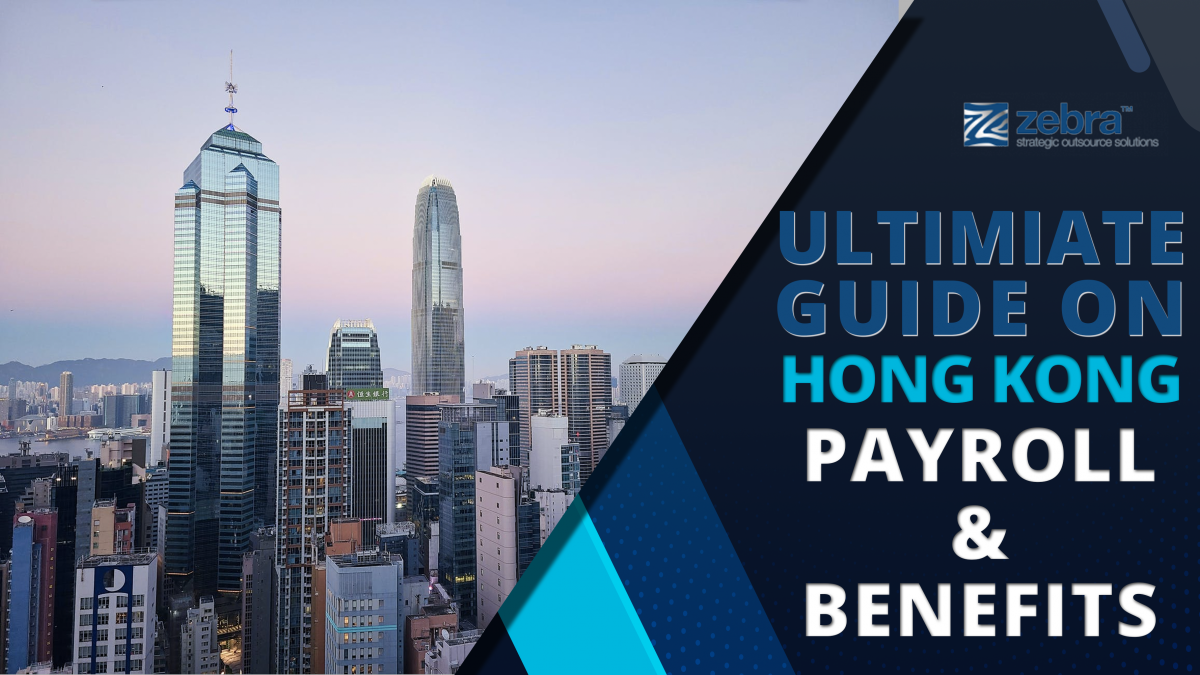
Payroll process involves specific laws and regulations according to where the business locates. Whereas as an international financial centre, Hong Kong is the hub for businesses to grow and bloom. Read the following to understand comprehensively on Hong Kong Payroll and benefits for your business.
General Information of Hong Kong
Hong Kong is formerly a colony of the United Kingdom. After its sovereignty was handed back to China in 1997, it became a special administrative territory of China located on the southern coast of the Chinese mainland. Yet, it maintains a separate political and economic system different from that of the mainland China. Hong Kong has become one of the world’s most important financial centres with an investment-friendly ambiance, laissez-faire government policy, and a low tax system. Hong Kong is a wealth off territory with high-quality healthcare and education, and high-income level. In the 20th century, Hong Kong industrialised swiftly with the services sector blooming to dominate the economy, contributing to almost 93% of economic output. Thanks to the strong regional and global trade links, Hong Kong’s GDP ranked third on the World Bank’s Ease of Doing Business Survey in 2019, making Hong Kong extremely attractive to international business.
Payroll Overview
Payroll Cycle | 13th Salary |
The payroll cycle is monthly in Hong Kong, and payments are usually being made on the last working day of the month. | It is conventional to pay the 13th salary during Chinese New Year or at the end of the year in Hong Kong. |
Income Tax
Corporate income tax rate | 16.5% for Hong Kong sourced profits from business carried out in Hong Kong. | |
Income tax rate | Gross income | Income Tax rate |
HKD 0-40,000 | 2% | |
HKD 40,001 - 80,000 | 7% | |
HKD 80,001 - 120,000 | 12% | |
HKD 120,001 + | 17% | |
There is no income tax withholding at source via payroll throughout the tax year in Hong Kong. Employees need to file his or her annual tax declaration and pay directly to the Inland Revenue Department while businesses have to report salary paid to employees by submitting an annual employer’s return.
Although there is no income tax withholding at source, the Inland Revenue Ordinance demands all taxpayers with an intention to leave Hong Kong to notify the Inland Revenue Department within a month before the expected date of departure. After receiving the notification, the department will decide whether the person needs to settle all tax liabilities before he departs. The employer of the individual is also required to give notification to the department of the employee’s departure no less than a month before the expected departure date. Meanwhile, the employer has to temporarily withhold payments to that employee until receiving the department’s “letter of release”
Mandatory Provident Fund Scheme
Employer Payroll Contributions | |
5% | Mandatory Provident Fund (Maximum taxable income is HKD 30,000) |
HKD 1,500 | For earnings over HKD 30,000 |
5% + HKD 1500 | Total Employment Cost |
Employee Payroll Contribution | |
5% | Mandatory Provident Fund |
HKD 1,500 | For earnings over HKD 30,000 |
5% | Total Employee Cost |
The Mandatory Provident Fund is a mandatory savings policy established by the Hong Kong government as a primary protection mechanism for the elderly and retirees. The system is compulsory for all Hong Kong employees with a 60-day or longer employment contract, as well as self-employed people aged 18 to 65. Foreign residents who work in Hong Kong for less than 13 months or who are insured by the retirement system of another country may be excluded.
The employer is responsible to choose the MPF provider and employees are expected to join the MPF provider of their new employers when they change job. When an employee switches jobs, his or her MPF assets are fully vested and transferrable. Benefits that have accumulated under a former company's plan might be transferred to a plan run by the new employer. The sorts of assets allowed in investment funds are strictly regulated. MPF providers, on the other hand, may give its members more than one investment choice based on the criteria through different funds, allowing employees to create their own investment portfolio using the funds offered by the provider chosen by their employers. Employees can choose their asset allocation from a variety of funds offered by their providers, but only for their portion of the retirement contribution.
According to the Mandatory Provident Fund Ordinance, the employee will automatically join the employer's MPF Scheme after working for 60 days. Employers and employees need to make monthly compulsory contributions of 5% of the employee’s relevant income including wages, salary, leave pay, fees, commissions, bonuses, gratuities, perquisites or allowances, but excluding severance payments or long service payments under the Employment Ordinance respectively to an MPF scheme, subject to the minimum and maximum relevant income levels. For a monthly-paid employee, the current minimum and maximum relevant income levels are $7,100 and $30,000 respectively. And both employees and employers can make voluntary contributions on top of the mandatory contributions.
On or before the contribution day, the necessary contributions for a contribution period should be transferred to the MPF trustee. The contribution day for monthly-paid employees is usually the 10th of each month. For example, contributions for the October contribution period should be made on or before November 10th.
Minimum Wages
The hourly minimum wage is 37.50 HKD.
Working Hour
In Hong Kong, compensation packages including work hours and days are flexible and specified in the employee contract. While a normal working week runs from Monday to Friday from 9am to 6pm, with no legislated working hours.
In a seven days period, the Employment Ordinance required a minimum of one rest day. Employees can also be rewarded in a variety of ways, ranging from a wage to a variety of benefits. Employers have no restrictions on how they can reward their staff. Employers, on the other hand, must pay their employees by the end of the wage period. Employers must pay interest on delayed salaries if they take more than seven days longer than the previous day, or risk legal consequences.
Holiday

Paid Time Off
Employees who have worked for at least three months have the right to have seven days of paid annual leave. The annual leave increases by one day every year until it reaches a maximum of 14 days in the 9th year of employment.
Public Holidays
All employees are entitled to statutory holidays. However most employers extend entitlement to all general holidays. In Hong Kong, there are 12 statutory holidays and 5 general holidays.
Sick Days
Employees under an employment contract are granted paid sick leave. In the first year of employment, employees are entitled to two paid sick leaves per month, increasing to four paid sick days per month after one year of employment. Prior to the first day of sickness, sick pay is computed at a rate of 80% of average daily earnings for the preceding 12-month period. If the employee has been working for less than a year, the computation is based on the employee's average earnings since the start date of employment. Employees can accumulate sick days throughout their employment, up to a total of 120 days.
Maternity Leave
If a pregnant employee has been working under a continuous contract for at least 40 weeks immediately prior to the start of her maternity leave, she is entitled to 14 weeks of maternity leave, with the possibility of an increase to 18 weeks if the delivery is complex or multiple. Between two and four weeks before the delivery date, maternity leave should begin. The government will repay the employer for the maternity payment based on a computation of four-fifths of their average daily income up to a maximum of 80,000 HKD.
Paternity Leave
If a new father has been employed under a continuous contract for at least 40 weeks prior to the first day of paternity leave, he is entitled to 5 days of paid paternity leave.
Termination
 Process of Termination
Process of Termination
Unless an employer can establish reasonable grounds for dismissal without notice, the termination procedure is standardised in Hong Kong based on Labor Law standards. In addition, written notification of termination must be submitted to the appropriate government authorities.
Notice Period
In Hong Kong, notice periods are usually 30 days, however, employers can stipulate lengthier notice terms in the employment contract.
Severance Pay
When appropriate, severance compensation is required in Hong Kong and is decided by the terms of the employee's contract and length of service. According to the Employment Ordinance, the employer must determine severance pay (Cap. 57). In general, an employee is entitled to statutory severance compensation if he or she has been working under a continuous contract for a minimum of two years and has not quit or been summarily dismissed before termination. For each year of service, statutory severance compensation is computed as two-thirds of the employee's normal monthly wage rate or two-thirds of 22,500 HKD, whichever is less. The highest amount of statutory severance payout is 390,000 HKD.
How Zebra can Help You
Zebra takes pride in offering professional and complete end-to-end payroll outsourcing services in full accordance with local employment legislation as a leading human resource firm in Hong Kong. It automates payroll processing and guarantees that employee benefits and compensations are calculated correctly. It lowers the expense of inaccuracy caused by human error. When needed, legal and human resources guidance is also offered. After subscribing to Zebra's ePayroll solution, you no longer need to worry about the payroll process.





